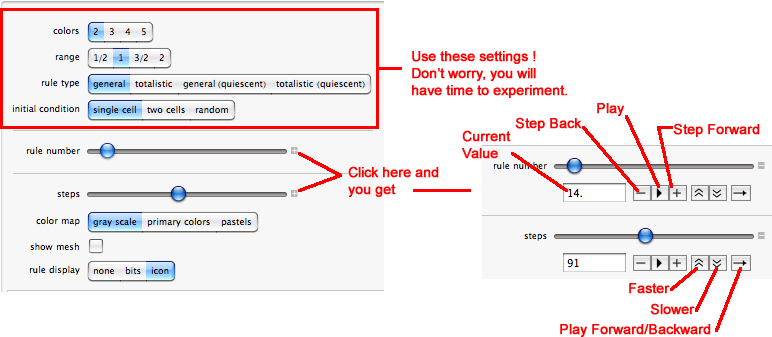Computers are a lot better at following simple, repetitive rules than people are. Let's turn the job of creating CAs over to the computer. Download the Cellular Automaton Explorer from the Wolfram Demonstrations Project site. (You may also need to download the Mathematica Player, but it's free.) The control panel of this demonstration looks like this:

Be sure to set the controls for colors, range, rule type and initial condition as shown above, so you will get elementary CAs. You can choose any color map you like, and showing the underlying mesh is optional. If you set rule display to "icon", the program will display the current rule in the form that you are accustomed to. Don't worry - there will be time to explore later. Notice that if you click the gray box next to the sliders, they open up and give you more control of what happens.
Most elementary CAs are very simple patterns - what you would expect from a few simple rules. On the other hand, some elementary CAs display rather elaborate patterns, and once in a while, nested patterns (small patterns imbedded in a bigger pattern which is imbedded in an even bigger pattern, etc.) emerge. This behavior is surprising. Once in a great while, an elementary CA displays extremely chaotic behavior - even seemingly random behavior. (Check ECA's 30 and 110.) This is very unexpected - how can a few simple rules produce such complex behavior?
There are 256 elementary CAs - check them out. (No, you don't have to look at all of them - but why not?) If you set the steps slider to a low value, you can see how the CA evolves according to its rule. A high steps setting will show the "big picture."
Find at least five elementary CAs that interest you, and copy their images, along with their rule, into a Word document. (<Shift><Command><4> on the Mac lets you select an area of the screen to print.) Then Insert -> Picture-> From File will paste it into Word. Write a short statement for each one telling what interests you about it, or why it "caught your eye."
Here are some things to ponder.
last update December 4, 2009 by JL Stanbrough